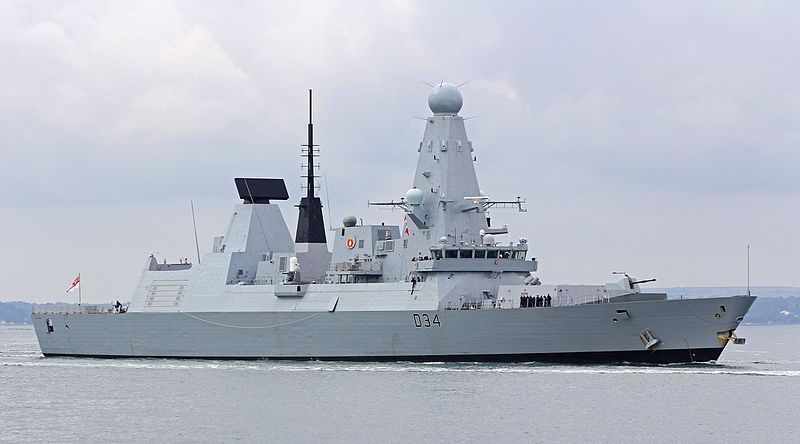
HMS Diamond (D34), a guided missile destroyer deployed to the Red Sea to counter Ansarallah (‘Houthis’), is withdrawing ‘for maintenance.’ The frigate, HMS Richmond (F239), will take its station in the Red Sea, but it offers inferior air defense capabilities, rendering the British contribution to ‘Operation Prosperity Guardian’ a token one.
‘Maintenance’ is probably for replacement of HMS Diamond’s vertical launch system (VLS), but given the Royal Navy’s travails,[1] it could actually be for maintenance. Claims that it was damaged by a ‘Houthi missile’ cannot be accepted without visual evidence. The Royal Navy is not the focus here. Diamond’s experiences offer insights into Ansarallah’s ‘long game’ in enforcing a Red Sea blockade of ships destined for Israel, and how their strategy of patience and gradual escalation may impact on U.S. naval forces in ‘Prosperity Guardian,’ and ultimately, on the U.S. mission to protect Israel.
Diamond’s SAMPSON multi-function tracking radar and fire control systems (and associated air surveillance systems) are excellent, and said to be capable of tracking 2,000 targets—even those as tiny as a ‘cricket ball’ (Americans: about the size of a baseball). But the weakness is Diamond’s Sylver Vertical Launching System: the six, 8-cell launcher modules (i.e., 8 x 6; in total, 48 vertical launch surface-to-air missiles). Each module is 6 m2 and has exhaust vents. Once depleted, a module has to be extracted and replaced. VLS reloading cannot be done at sea; the ship must return to port to reload VLS—and not just any port, but one that has facilities and technicians for this task.
This is where the problem arises for the US Navy. USN is a ‘forward-based navy’: dependent on access to friendly foreign ports and American home ports for refurbishing and re-arming. USN had not been an ‘expeditionary navy’ since the 1990s: a naval force with tenders and technicians; self-sufficient and not dependent on friendly ports.
Diamond’s Commander Peter Evans said, ‘the situation in the area is dangerous, and the force’s ships are firing on a daily basis.’ Ansarallah can count. Diamond has 48 SAMs. If it launches 35 SAMs, it has 13 SAMs left—along with other defensive layers, particularly, Phalanx CIWS, electronic warfare (EW), and decoys. At this point, if, say, Ansarallah launches a saturation attack (i.e., swarm attack)—scores of drones and missiles—it will be irrelevant that SAMPSON can track thousands of flying cricket balls or golf balls. The ship will run out of missiles and be dependent on CIWS as its last layer of protection. CIWS is efficient and effective, but not infallible.
This is the heart of the problem. Ansarallah—and any IRGC officers attached to them—are aware of each ship’s defensive capabilities and exactly or approximately how many missiles it launched. ‘To date [1 Feb 2024] the [American] destroyers Gravely, Thomas Hudner, Mason, Laboon and Carney have downed more than 50 drones and around 20 missiles launched into the Red Sea.’ There have been more missile launches and intercepts since then. One analyst focused on the cost per missile, estimated at $1 mil. to $4.3 mil. depending on model of SAM, but cost is not the issue. Social media users sniggered at the ‘misses’ by Ansarallah, but they miss the point. Each time Ansarallah launches a missile at a ‘blockade breaker’ ship or USN ship, US Navy ships ‘light up’ their AEGIS Combat System and launch interceptors. Each SAM launch depletes VLS silos; electronic signals emitted by USN ships provide critical electronic intelligence to Iranian intelligence gathering vessels like the Behshad in the Gulf of Aden.
There will come a point where Ansarallah will decide that a USN ship (or carrier that it is escorting) is vulnerable because VLS silos are low; that Ansarallah has sufficient electronic intelligence to employ EW to spoof AEGIS; and launch a saturation attack that depletes VLS and forces the vessel to rely on CIWS. On 1 Feb 2024, one missile came within one mile of USS Gravely, compelling its crew to engage CIWS. It is unclear how the missile bypassed interceptors. Could it be the result of EW? A new type of missile? In any event, the incident is a harbinger.
Attacks by Ansarallah and counter measures by U.S. ships must be examined in the continuum. Both sides learn from every attack/defend incident, but in asymmetrical warfare, an American ship must be accurate every time (100%), while Ansarallah need only be accurate once. If—and this is likely to happen—an American ship is struck, possibly sunk, it will compel Washington, D.C. to defend its goal of safeguarding Israel’s economic lifelines with American lives.
[1] Diamond has experienced ‘technical issues’ in the past. On 21 January, two RN ships, HMS Bangor and HMS Chiddingfold, collided while docking in Bahrain. Video of the incident went viral and almost broke the internet with laughter. HMS Westminster and HMS Argyll were allegedly decommissioned due to lack of crews. The aircraft carrier, HMS Queen Elizabeth (R08), which was supposed to join the upcoming NATO exercise, ‘Steadfast Defender 2024,’ had to withdraw, ostensibly due to a ‘propeller shaft’ problem, prompting one wag to comment, ‘Royal Navy shafted by the Royal Navy.’ RN is out of its depth.
You must be logged in to post a comment.